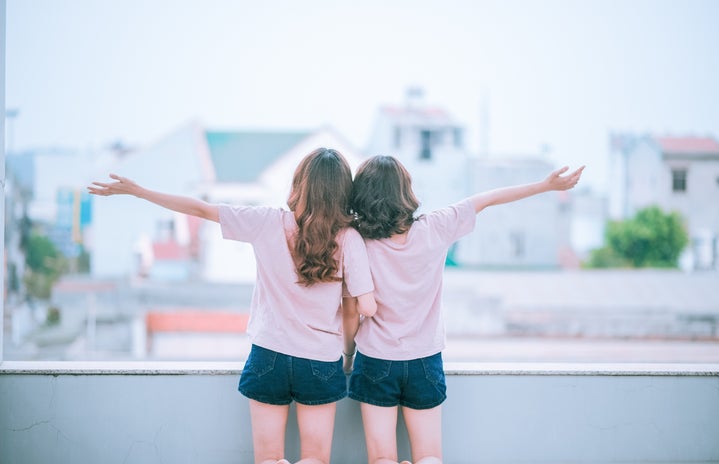Cancer. A word that everyone is far too familiar with, yet most people don’t like to talk about. It is estimated that 1,658,370 new cases of cancer will be diagnosed in the U.S. in 2015, and one of the most commonly diagnosed is breast cancer. Approximately 12.3% of women will be diagnosed with breast cancer at some point in their lives, and in 2012, there were estimated 2,975,314 women living with breast cancer in the U.S. That being said, there is hope. Breast cancer is one of the more treatable cancers, with 84% of those diagnosed living 5 or more years after their diagnosis.
Because it is so common, breast cancer is pretty well-known with a large and public fundraising community. I’m sure everyone has heard the phrase “save the boobies” at least once or twice, and seen the flood of pink when October, which is National Breast Cancer Awareness Month, rolls around. I did a fair amount of fundraising when I participated in the Susan G. Komen 3-Day for the Cure when I was 16.
Before I get into sharing my experiences with that, I want to focus on an aspect of breast cancer awareness that is often overlooked, and that is early detection. Breast cancer is very treatable if detected early. It is crucial for women to know how to detect early signs of breast cancer. For women over 40, it is recommended that they should have mammograms performed every 1-2 years. According to the National Breast Cancer Foundation, “a mammogram is an x-ray that allows a qualified specialist to examine the breast tissue for any suspicious areas. The breast is exposed to a small dose of iodizing radiation that produces an image of the breast tissue”. 40 seems pretty far off for most of us, but that doesn’t mean that there isn’t anything we should be doing. It is recommended that all adult women perform breast self-exams at least once a month. Here are step by step instructions provided by the National Breast Cancer Foundation:
1) In the Shower
Using the pads of your fingers, move around your entire breast in a circular pattern moving from the outside to the center, checking the entire breast and armpit area. Check both breasts each month feeling for any lump, thickening, or hardened knot. Notice any changes and get lumps evaluated by your healthcare provider.
2) In Front of a Mirror
Visually inspect your breasts with your arms at your sides. Next, raise your arms high overhead.
Look for any changes in the contour, any swelling, or dimpling of the skin, or changes in the nipples. Next, rest your palms on your hips and press firmly to flex your chest muscles. Left and right breasts will not exactly match—few women’s breasts do, so look for any dimpling, puckering, or changes, particularly on one side.
3) Lying Down
When lying down, the breast tissue spreads out evenly along the chest wall. Place a pillow under your right shoulder and your right arm behind your head. Using your left hand, move the pads of your fingers around your right breast gently in small circular motions covering the entire breast area and armpit.
Use light, medium, and firm pressure. Squeeze the nipple; check for discharge and lumps. Repeat these steps for your left breast.
Another way to detect early signs is to have a clinical breast exam done by your doctor at your annual exams, because they are trained to recognize any abnormalities or warning signs.
Now, on to my own experience. Regardless of the controversy surrounding Susan G. Komen and the allocation of funds, the 3-Day was an experience I will never forget, and opened my eyes to the reality of breast cancer. I don’t remember when I first learned about breast cancer, but during my sophomore year of high school, I became pretty involved with fundraising through a friend. This friend had lost her grandmother to breast cancer, which led her mother to start a non-profit called Pink Courage. Through my friend and her mother, I was introduced to the Susan G. Komen 3-Day for the Cure. For those of you who are unfamiliar, the 3-Day is a 60 mile walk to raise awareness and funds for breast cancer research. They hold walks in large cities around the US, including the Twin Cities, which is the one I participated in, but fundraising was not an easy feat. After months of asking for donations and selling merchandise, I finally met the required amount.
During the time that led up to the walk, my mom shared with me that she had had a lumpectomy in 2005 after having an abnormal mammogram. I have vague memories of when this happened, but obviously was not aware of what it meant, since I was 9 at the time. We have been very fortunate that the surgery completely took out the cancerous lump, and there haven’t been any abnormalities since. Knowing this definitely made the walk that much more personal and meaningful for me.
I had mixed emotions during the weeks leading up to the walk. I was excited, but there was also a little bit of fear that crept up every once in awhile. Fear that I should’ve trained more. Fear that I wouldn’t be able to do it. Fear of spending a weekend with unfamiliar people. Fear of disappointing those who supported me. Then it was five a.m. and I was standing in the K-Mart parking lot— the start of the walk. After the opening ceremony, we were off.
20 miles a day turned out to be pretty grueling. 16 year old me, of course, did not train very much, thinking I was in great shape. Turns out, walking 60 miles isn’t about what shape you’re in— it takes a toll on your body, no matter what. 3 days of sore muscles, countless blisters, and 3 toenails falling off (TMI?) later, we were at the finish line. And that, I think, is where the beauty in the 3-Day is. Everyone was sore, but it didn’t matter. What mattered were the people who fought breast cancer and lived to walk those 60 miles. What mattered were the people who walked the 60 miles for their loved ones— those lost and those still fighting this horrible disease. What mattered were their stories, their strength, and their resilience. For me, that is what the 3-Day represented. It represented the hope that through education and research, we can beat this disease to make sure no one has to go through what so many women have had to go through.
So, I encourage you all to learn about breast cancer and how you can support the cause, not just during October, but all throughout the year.

